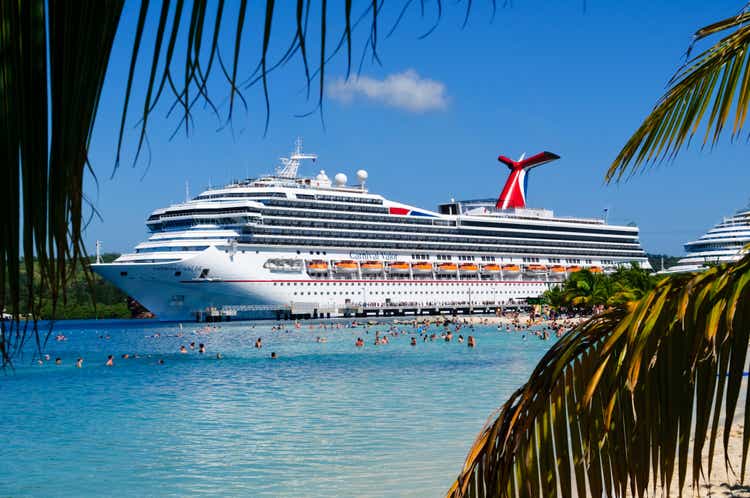Summary:
- Carnival has seen continued choppy operating conditions.
- The largest convertible bond issue suggests financial distress remains high.
- Even if operating losses have narrowed, it’s a significant debt load (and higher interest rates) which cast a dark shadow.

Joel Carillet
On the first day of October I concluded that shares of Carnival (NYSE:CCL) were doing well. I observed that the company has seen a solid third quarter, amidst spectacular sales growth, yet operating losses were still persisting.
Higher interest expenses going forward, and already high occupancy rates were limiting the potential to drive operating leverage in the quarters to come, creating a very uncertain set-up given the huge debt load of the business.
Some Background Perspective
Ahead of the pandemic, Carnival was a business which generated $20.8 billion in revenues, from operating multiple cruise line franchises, on which it posted steep operating earnings of $3.3 billion, and net earnings of $4 per share on the back of a near 700 million share count. These shares traded around the $50 mark at the time, for a $35 billion equity valuation, as an $11.5 billion net debt load translated into a $47 billion enterprise valuation at the time.
Net debt was large in relation to the earnings power, but this is a very asset-intensive business with ships carrying a $38 billion book valuation (at the time). Following the outbreak of the pandemic, revenues plunged to just $5.6 billion on which huge $9 billion operating losses were reported, only in part explained by large depreciation and amortization charges.
Shares fell to the low single digits, yet a rally to the $30 mark in 2021 surprised me a great deal as quarterly revenues came in at $26 million at the time, as this is not a typo. At the same time, the company kept incurring dilution and net debt, which makes that the decline in the enterprise valuation was much less pronounced than the share price suggested.
2021 revenues fell to just $1.9 billion as operating losses surpassed $7 billion, dismal numbers by all means. Even as first quarter sales rose to $1.6 billion this year, an almost equal operating loss was reported at the time. Second quarter revenues rose to $2.4 billion, yet operating losses were stuck around $1.5 billion amidst inflationary pressures and higher start-up costs.
The company kept on selling shares, offering another 100 million shares at $10 in July, as 10% dilution brought the company a billion in gross proceeds, sufficient to finance the burn rate for just about two months.
In September, Carnival announced third quarter revenues at $4.3 billion which is encouraging, as a $17 billion run rate (albeit in a good season) looks quite strong, yet a quarterly operating loss of $279 million revealed continued losses. The issue besides the operating losses is that interest expense run at over $400 million per quarter already, with higher interest rates and higher debt hurting the results on the bottom line. The problem is that with occupancy being high already and inflation being high, the extent of a recovery in topline sales and contribution margin from here is getting more limited, as realistic losses remain huge.
This is the case as net debt has risen to $27 billion in September as the share count has risen to 1.2 billion shares. While the shares only represented a $10 billion valuation in September, the enterprise valuation of $37 billion is down just very modestly from pre-pandemic levels, despite a substantial worse earnings profile.
Given the poor risk-reward, I continue to be cautious as the ship continues to make water.
And Now?
Shares of Carnival fell to $6 in October amidst worries about higher interest rates into the future. Amidst hopes about interest rate policies being looser than thought, in terms of the policy employed by the Fed, shares rallied to the $11 mark in recent weeks. That changed overnight again as the company announced a billion offering of convertible notes.
While the $1 billion in 2027 notes carry a relatively reasonable 5.75% interest rate, it comes with a conversion price of $13.39 per share, which implies that the share count will increase by another 75 million shares, if shares recover further, marking another 6% dilution down the road (if this becomes opportune).
In my view they might have better even sold the shares outright, avoiding a $57.5 million annual interest expense which is incurred now as well. The latest move shows the continues trend that such kind of money is really only good to finance the cash outflows for just a few months time.
While the company extents the maturity of its debt in a minimal fashion through this deal (with proceeds used to buy back 2024 loans), the reality is that the situation remains dire by all means, as the optimism on the back of lower future interest rates might be a bit overdone. For me Carnival remains uninvestable until some kind of restructuring (both equity and debt in likelihood) will need to be executed.
Disclosure: I/we have no stock, option or similar derivative position in any of the companies mentioned, and no plans to initiate any such positions within the next 72 hours. I wrote this article myself, and it expresses my own opinions. I am not receiving compensation for it (other than from Seeking Alpha). I have no business relationship with any company whose stock is mentioned in this article.
If you like to see more ideas, please subscribe to the premium service "Value in Corporate Events" here and try the free trial. In this service we cover major earnings events, M&A, IPOs and other significant corporate events with actionable ideas. Furthermore, we provide coverage of situations and names on request!
